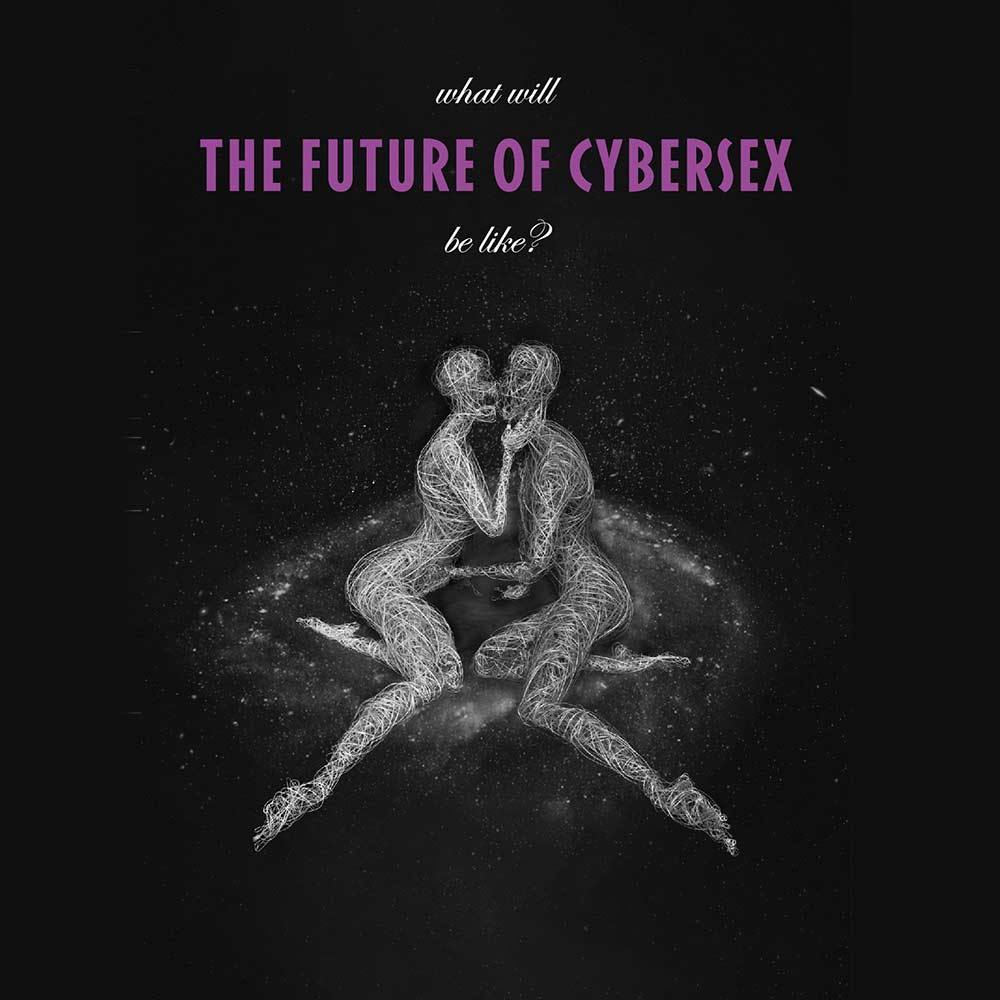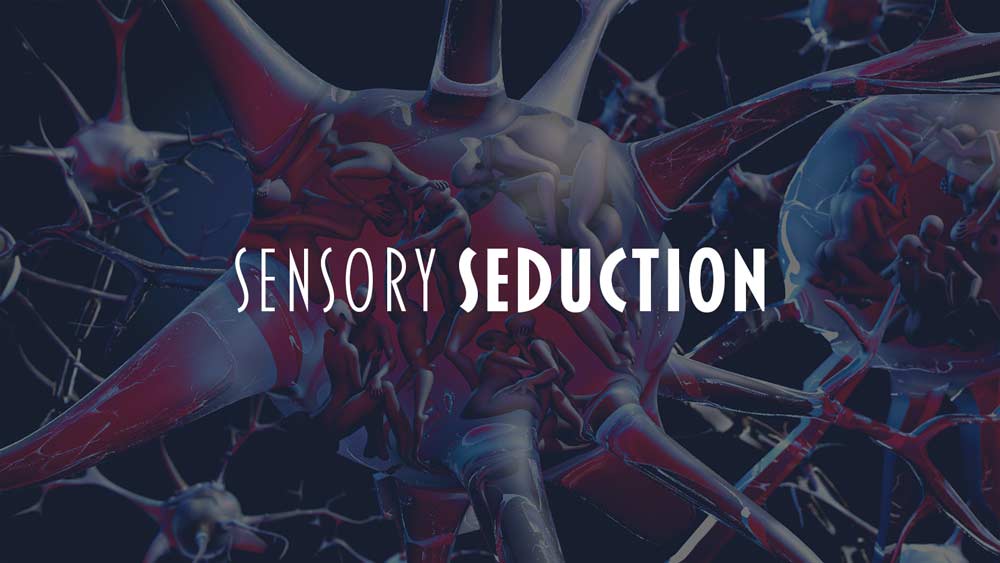
Sensory Seduction is a long-term project, and what you are about to see in September is just a first phase
Feel, see, hear, smell, taste – all five senses are stimulated during sex. Unfortunately, the same cannot be said about the use of sex toys; those experiences are usually limited to the sense of touch without providing stimuli to the other senses. Now, a young start-up called Raspberry Dream Labs has set out to address this issue and look for ways to trigger the entire bandwidth of human sensory perception. Their research into multi-sensory experiences will culminate at the beginning of September, during an event in London that is called “ Sensory Seduction: Immersive Study.” Since our interview with the founder of Raspberry Dream Labs, Angelina Aleksandrovich, took place before the study, she didn’t want to go into detail too much. But we do shine a spotlight on many interesting aspects that may well have a big impact on the future of sex tech, and we talk about ways to stimulate those senses that are often neglected in the sex toy experience.
Raspberry Dream Labs is “a team of artists and engineers drawn together to create multi-sensory innovations in sex tech”. What exactly is a multi-sensory innovation when it comes to sex and technology?
Angelina Aleksandrovich: I see two questions here. First of all, what is a multi-sensory innovation? This is a broad term covering new methods, programmes, products, and creative innovative applications of existing tools, that are engaging with humans on more than one sensory level. How it relates to sex and technology? Very straightforward, actually. Innovations that affect us sexually through more than one sense. All events in this “world” are usually multi-sensory and so is sex. It is a combination of what one sees, hears, smells, tastes, and feels that makes us sexually aroused. Thus, by targeting more than one sense we’re blurring the line between what is perceived as “real” world and simulation, regardless of context. It just happened to be that I’ve chosen to focus on sexuality.
Throughout the history of a mankind, senses have always been re-adjusting their significance and values to cultural needs. For example, the industrialisation and technological advances of 19th century led to big changes in the perception which primarily affected and extended to the sense of sight, influenced by the switch from steam to electricity, the development of wireless telegraphs and telephones, the invention of the camera obscura, the stereoscope, the microscope, the telescope, and more. Meanwhile, hearing and smell became dulled as they suffered the negative side effects of ever-increasing noise and smell pollution. And the sense of touch only started developing its significance in the 20th century with the increased interest in sensory physiology and inventions such as touch screens, keyboard, mouse, and interactive monitors. Now, as a 21st century citizen, I truly believe that the future of innovations will be multi-sensory. Perhaps we will also invent new senses as we progress with immersive technologies and genetic modifications.
How did you come up with the idea to start Raspberry Dream Labs?
I’ve been interested in sex since my early childhood, lacking early age sex education and hearing from my parents that they found me in the cabbage or that a stork dropped me by their house (yeah, their stories didn’t always match), I’ve always been alone on my journey of discovering the truth about sex.
Growing up in Eastern Ukraine in the late 90s – early 00s didn’t help with that either. Discovering myself as a sexual being as an early teenager wasn’t warmly welcomed by my peers – when I was 12, I looked (and felt) like a fully formed woman, and of course I wasn subjected to giggles, nasty jokes, and dirty comments. When I moved to the UK, I found relief in expressing myself in art, often using my body as the primary tool for making art, exploring subjects of identity, sex, and robotics. Then I realised that what I was doing wasn’t sustainable to make a living, and I went to study Graphic Design Communications at the University of the Arts in London. I was always fascinated by technology and how it can work together with nature to create new possibilities for mankind. So, for my graduation work, I grew a VR headset out of mushroom mycelium. That inspired me to seek a career in XR [cross reality] tech and I worked with many global brands full-time and freelance on various commercial projects. Then I started to play around with the idea of multisensory experiences, pitching to clients elements such as spatial audio, scents and temperature control. But I wasn’t feeling happy creating “brand experiences” for brands with whom I didn’t necessarily resonate just for the sake of being able to pay my rent. And at the end of 2018, I was looking through my hard drive and bumped on a folder with photos of my work back from art school. They made me feel very nostalgic and I realised how unhappy I was. But that also reminded me that I already found my passion, the subject of human sexuality, and that I was repressing it with all the corporate work I was doing. All I had to do was act upon it.
At first, I just wanted to make a cool project, combining my tech and production experience with my repressed passion. But once I started thinking it all through, there was no end to it. I decided to start a company.

Could you tell us a bit about the team behind the project and your goals?
I’m very glad you asked this question. I am a big supporter of holacracy and DAO, and this is the structure I want for the team. So far, I think we managed it well. We don’t have full-time employees, we don’t have an office, and we don’t have working hours; also, some of us have never even met face to face, but what we have is a shared belief in what Raspberry Dream Labs is set to achieve. Sometimes a strong belief is all that you need.
Our goal is to create a new, modern approach to human sexuality for the upcoming decades by stimulating all human senses with technology beyond the current offerings of sex toys and pornography.
When Raspberry Dream Labs was founded, I was in it by myself trying to do absolutely everything, with the occasional support from fellow advisors and volunteers-collaborators. All the way up until now, we were running with no funding, thus everyone helped as much as they could, especially during the ideation stages when nothing was solid and it was very hard for people to commit. But once I settled on the need to deliver the first immersive study (I also tend to refer to it as a proof of concept) and all initial objectives became very clear, the production team just formed itself very organically. We have:
Harry Sherwood – perfumer & scent engineer, currently doing his PhD at CenSes, Institute of Philosophy, School of Advanced Study, University of London.
Leonardo Gomes – electronics engineer conducting his PhD at the University of Sao Paulo, Brazil.
Laurentiu Fenes – XR developer specialising in interactive technology and VR experiences, London, UK
Sophie Langohr – 3D artist & founding partner of Les filles du 9 Novembre based in Paris, France.
Luke Burnsright – music producer, recording artist, sound designer and a founder of Sound Care Studios, London, UK.
Essentially, we have representatives of each sense (taste is coming soon!) and I’m being the nervous system and the brain connecting it all together.
Most recent sex tech products focus on physical stimulation in one way or another. You seem to follow a more holistic approach. What exactly is missing in the market right now?
The majority of these products lack emotional and sensory relevance, focusing solely on the path to an orgasm, taking the richness of our sensory palette out of equation. The increasing popularity of sex-related VR experiences creates new means for people to explore their sexuality and desires by engaging in safe and anonymous sexual experiences. These offerings are the closest comparable solutions to the problem we are tackling. The limitation of such experiences is that they solely rely on the literal visual representation of sex and genital stimulation. However, we believe sex is beyond that — it is a multisensory event resulting from a combination of various sensory stimuli – none of which should be neglected.
Between September 2nd and 10th, you are hosting an event called “Sensory Seduction: Immersive Study”. What can the participants look forward to?
Expect to be aroused, of course! Someone actually asked me if they have to have physical sex or masturbate there, but that’s not really our intention. We made it very clear in all our online and offline channels that this experience is not designed for orgasms, but to engage sexual accelerators through the sensory stimulation.
Participants have the option to attend the experience individually or with a partner. Upon arrival, they will be instructed on do’s and don’ts and given VR headset and wearables to put on. We allow 25 min per person / couple in total, including dressing up. Upon completion, the participants will be asked to fill in self-report forms.
We don’t want to say too much about what will happen during the actual experience. I mean, you don’t tell someone what you get them for their birthday until you actually give it to them, right? Otherwise what’s the point? I like building intrigue, and it’s nice to let people roam in their imagination. Some participants will be totally impressed, some maybe not. It depends on what picture they have already built in their mind, on their previous experiences, how tech savvy are they, what their mood is like, whether someone on their period … But really none of that matters; we are only interested in the ranges of feedback and valuable insights.

What insights do you hope to gain from this study?
I am currently writing a paper called “What is multisensory sexual arousal and how its implementation in XR will define the future of cybersex” and this Immersive Study is going to answer the following questions: What type of virtual multisensory environment can be arousing? Can it be arousing by itself or in the presence of a desired human? What is the optimal time spent in this environment? Which presented stimuli were the most arousing? And I’m pretty sure there will be more revelations and unexpected surprises during the analysis.
Sensory Seduction is a long-term project, and what you are about to see in September is just the first phase of larger upcoming research. Participants’ feedback will tell us what the community wants us to focus on in the next phase. Because at the end of the day, this is not about my artistic vision, it is about giving people what they want.
Given your background as an artist, how much of this is an experiment, and how much is art? Is there any difference at all?
The word “study” seems to be very at sensitive term as it comes down to who is conducting it, under what regulation, and why. That’s why at this particular stage, I like to call it “artistic study”.
There is a lot of shit art out there these days. How does one define good art from bad art? You can’t! At the end of the day, it’s a matter of preference. I like something, you don’t – either I can convince you to like it too, or I can’t. But when we speak about art informed by science or for science, we enter a different dimension. This art is justifiable and is for the cause, and in that sense, it doesn’t matter if someone likes it or not.
The beauty tends to emerge from a fusion of disciplines, and Raspberry Dream Labs sits at the intersection of three – art, academia, and business. I don’t want to assign what we do to one category or another because once you do that, the majority of people begin to expect certain things from it and there are regulations. I’m not a fan of that. I’d rather let people decide for themselves what they are dealing with. Perhaps it is the scientific art that sells?
“The beauty tends to emerge from a fusion of disciplines, and Raspberry Dream Labs sits at the intersection of three – art, academia, and business.”
How hard is it to put your ideas into practice? Is there already technology from other industries you can use?
The current set up is very much DIY. The only 3rd-party product borrowed from other industries that we are using right now is an Oculus Quest, all other pieces are assembled from things that you can find among multi-purposed tools in the hardware store.
That being said, if we had a budget to play with, we would certainly use many other existing tools, but more for internal research rather than the customer facing side.
What makes it hard putting ideas into practice is the financial restrain, not so much the technical hurdles, as so far, it’s all been self-funded.
Will there be a marketable product at the end of this process? Are there any concrete ideas about the end result?
This process in never-ending. This process may only end if all humans on the planet will stop having sex (physical, digital, virtual, abstract, metaphorical), thinking about sex, feeling and defining themselves as sexual beings, and engaging in any sort of activity that somehow involves the idea of sexuality. That actually sounds like the end of the world. I think we are very far from that. Even (especially!) when reproduction will no longer be tied to sex (by that I mean that foetuses will no longer require a female body to be developed) and when we will no longer be dependent on physical bodies – even then, sex still won’t be erased from being. It will still exist, solely for the sake of pleasure and fulfilment.
I’m getting carried away. What I’m saying is that our roadmap is huge and is leading very far into the future. But if we backtrack to the near present, then the answer is: Yes, we are developing a marketable product, but what it is I’m not going to tell you. It would be very silly for me to reveal my cards before making a move.
There is still a certain ambiguity attached to the term sex tech. Hence the question: What is sex tech to you ?
Technology that is created to improve everything to do with human sexuality, from children’s sex education to porn – the spectrum is very broad. Technology is exponentially pushing humans into new realms of existence. We create better and smarter ways of living – sex is not an exclusion. If we’re not going to innovate in this field and make sexuality and sexual wellness acceptable and available everywhere in the world … What will future generations be like if they are born in an age of social media censorship? Repressed and self-ashamed beings, a perfect herd for manipulations and brainwashing. That’s not really the future I want to see.
Let’s talk about the sensations that other sex sech products neglect. Why is there such a strong focus on genital stimulation at the moment?
Because it sells, it’s bulletproof. People will buy it and makers know that. There is a clearly defined market for genital-focused products, there is no need to re-educate the audience.
Doesn’t a product become overly complex if you want it to satisfy a person at all sensory levels?
In the beginning yes, but the more we learn about human multi-sensory capabilities the more we can simplify design and hardware requirements. It is a challenge, but the result is worth it.
What developments – especially with regard to multi-sensory experiences – should we keep an eye on in the near future?
Raspberry Dream Labs – I heard some good things about them!





